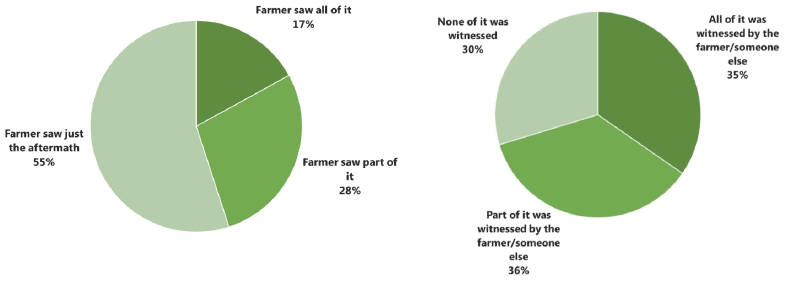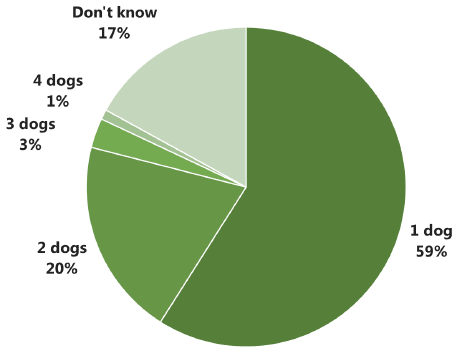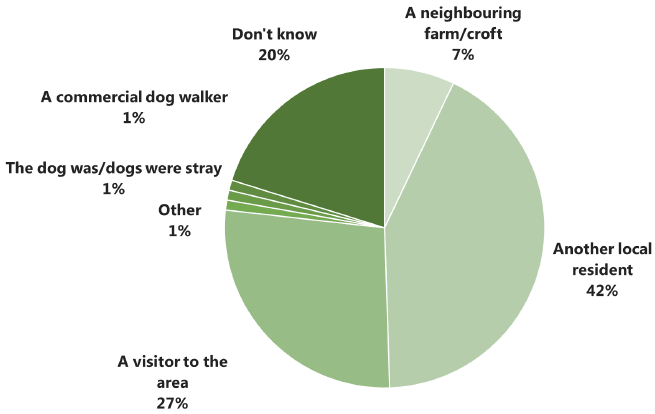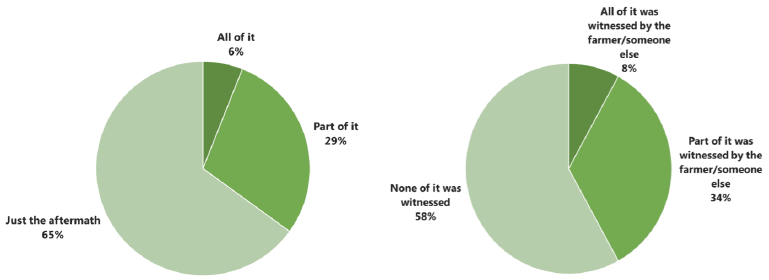Sheep attacks and harassment: research
Findings from survey research on sheep worrying and wildlife attacks on sheep.
5. Circumstances of attacks
Sheep farmers who had experienced at least one attack on their sheep in the last twelve months were asked a range of questions relating to the circumstances of the most recent incident.
Dog attacks
Half of those who had experienced a dog attack within the last twelve months reported that the most recent incident involved physical contact with the sheep (49%), while the other half (51%) reported that their sheep were chased by the dog but there was no physical contact.
45% of respondents had personally witnessed the incident and 17% had witnessed it in full.
Figure 5.1 Whether farmers personally witnessed the most recent dog incident and whether it was witnessed by anybody (% respondents)

Base: All those whose sheep had been chased or attacked by dogs in the last 12 months (293)
In most of the cases where sheep farmers had not personally witnessed the incident in full, they reported that somebody else had witnessed the incident. Overall, as shown in the chart on the right above, around 71% of incidents were witnessed either by the farmer or by someone else. In around a third of cases of dog attacks, however, (30%) the incident had neither been witnessed by the sheep owner nor anybody else that they were aware of.
More than half of the dog attacks involved just one dog (60%), while a fifth of attacks (19%) involved two dogs. The average (mean) number of dogs reported to have been involved in an incident was 1.4. Incidents involving more than two dogs were much rarer, with just 3% of affected farmers reporting the involvement of three dogs and just 2% reporting an attack with four dogs. There was one report of an incident involving five dogs.
Figure 5.2 Q How many dogs were involved?

Base: All those whose sheep had been chased or attacked by dogs in the last 12 months (293)
In half of the dog attacks reported (49%), farmers believed the dogs were accompanied at the time of the attack, while in 38% of cases the dogs were believed to be unaccompanied and in 13% of cases the respondent did not know.
Most commonly, respondents were under the impression that the dog(s) belonged to another non-farming local resident (42%), with 27% reporting that the dog(s) belonged to a visitor to the area and 7% reporting that the dog(s) belonged to a neighbouring farm/croft. Very few were stray or the responsibility of a commercial dog walker at the time (1% in each case).
Most of the visitors' dogs were accompanied at the time of the incident (80%) while most of the dogs from neighbouring farms/crofts were not (only 26% were accompanied). There was no clear trend among the dogs belonging to non-farming local residents with similar numbers believed to be accompanied and unaccompanied.
Figure 5.3 Q Who did the dog belong to?

Base: All those whose sheep had been chased or attacked by dogs in the last 12 months (293)
Wildlife attacks
In contrast to the incidents with dogs, where the split was roughly even between dogs chasing and physically attacking sheep, more than nine in ten (94%) reported incidents with wildlife species involved physical contact with the sheep, while just 5% of respondents reported that their sheep were chased but not attacked in their most recent wildlife incident. This perhaps reflects the fact that farmers may be less aware of incidents where wildlife harassed their sheep but did not make physical contact. It may also reflect the fact that wildlife attacks, unlike dog attacks, are more likely to be driven by predation than a more 'playful' drive to chase. As shown in Figure 5. 4 below, respondents were much less likely to witness wildlife attacks than dog attacks: partly because foxes and badgers will tend to be active at night, and partly, perhaps, because dog incidents may create more of an obvious disturbance. Besides the nocturnality of many wildlife species, these species may also be more highly sensitive to the presence of humans nearby, and more likely to avoid activity in these circumstances, compared with dogs.
Figure 5.4 Whether farmers personally witnessed the most recent wildlife incident and whether it was witnessed by anybody (% respondents)

Base: All those whose sheep had been chased or attacked by a wildlife species in the last year (840)
Respondents who had experienced a wildlife attack in the last year were asked what species they thought was involved in the most recent incident. Foxes were thought to account for the highest number of wildlife attacks reported, comprising a quarter (25%) of attacks, while crows and ravens were thought to be responsible for a further two fifths of attacks (20% and 19% respectively). A further one in ten attacks were attributed to badgers (11%), while white-tailed sea eagles and black backed gulls[46] were each believed to be responsible for 6% of attacks and skuas and golden eagles for 3% and 1% each.
Figure 5.5 Q What species do you think was involved {in the most recent incident]?
![Figure 5.5 Q What species do you think was involved {in the most recent incident]? Figure 5.5 Q What species do you think was involved {in the most recent incident]?](/binaries/content/gallery/publications/research-analysis/2019/12/sheep-attacks-harassment-research/SCT11195505701_g12.gif)
Base: All those whose sheep had been chased or attacked by wildlife in the last twelve months (840)
There was considerable regional variation related to the species involved.[47] In Tayside, foxes were believed to account for more than half of the most recent incidents reported (51%), followed by Clyde Valley where they were thought to account for just under half of the most recent incidents (46%).
Crows, meanwhile, were the most highly reported species in Dumfries and Galloway: respondents attributed more than one third (34%) of the most recent wildlife attacks to crows.
There were more reports of raven attacks than average in the western regions of Eileanan an Iar, Ayrshire and Argyll & Bute, in each of which they were the most reported species, believed to account for 42%, 33% and 35% of the most recent incidents respectively.
Badgers were the most reported species in NE Scotland and the Scottish Borders, where they were thought to account for around a third of the most recent attacks in the two regions (32% and 30%).
White-tailed sea eagles were reported almost exclusively in Eileanan an Iar, Highlands and Argyll & Bute, where they were thought to account for 16%, 14% and 13% of attacks respectively, while Golden Eagles were almost exclusively reported in Eileanan an Iar (13%).
There were much higher than average reports of both black-backed gulls and skuas in Shetland, where each species were believed to account for 28% and 38% of reported attacks respectively.
Contact
Email: socialresearch@gov.scot
There is a problem
Thanks for your feedback